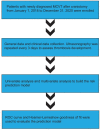A risk prediction model for evaluating thrombosis extension of muscle calf venous thrombosis after craniotomy
- PMID: 36311954
- PMCID: PMC9614109
- DOI: 10.3389/fsurg.2022.992576
A risk prediction model for evaluating thrombosis extension of muscle calf venous thrombosis after craniotomy
Abstract
Objective: To explore the risk factors of muscle calf venous thrombosis (MCVT) after craniotomy and construct a risk prediction model, so as to provide tool for evaluating the prognosis of MCVT after craniotomy.
Methods: Retrospective analysis was performed on the data of patients undergoing craniotomy complicated with MCVT from January 1, 2018 to December 31, 2020. A prediction model was established by Logistic regression, and the predictive efficacy of the model was tested by ROC curve. The accuracy of the risk model was evaluated by Hosmer-Lemeshow (H-L) test, and the model was verified internally by cross validation.
Results: Among the 446 patients who underwent craniotomy complicated with MCVT, 112 cases (25.11%) had thrombosis extension. D-dimer, Capirini scores, length of hospital stay, malignant tumor, fracture, use of dehydrating agents and hemostatic agents were independently related to thrombosis extension after craniotomy. The area under ROC curve (AUROC) of the prediction model was 0.918 (0.888, 0.942), and the sensitivity and specificity of the maximum Youden index were 85.3% and 78.2%, respectively. H-L test showed that the prediction model was accurate (χ 2 = 12.426, P = 0.133). The internal verification results of the prediction model showed that the AUROC value of the prediction model is 0.892.
Conclusion: The prediction model has a good prediction efficacy on the prognosis of post-craniotomy patients complicated with MCVT, and can be used as a tool to evaluate the risk of thrombosis extension.
Keywords: craniotomy; muscle calf venous thrombosis; nursing; prediction model; thrombosis extension.
© 2022 Li, Chen, Liu, Lin, Ren, Wang, Zou and Gu.
Conflict of interest statement
The authors declare that the research was conducted in the absence of any commercial or financial relationships that could be construed as a potential conflict of interest.
Figures
Similar articles
-
Development of Risk Prediction Model for Muscular Calf Vein Thrombosis with Acute Exacerbation of Chronic Obstructive Pulmonary Disease.Int J Gen Med. 2022 Aug 10;15:6549-6560. doi: 10.2147/IJGM.S374777. eCollection 2022. Int J Gen Med. 2022. PMID: 35974801 Free PMC article.
-
Short-term and mid-term outcome of isolated symptomatic muscular calf vein thrombosis.J Vasc Surg. 2007 Sep;46(3):513-9; discussion 519. doi: 10.1016/j.jvs.2007.04.040. Epub 2007 Jul 30. J Vasc Surg. 2007. PMID: 17681715
-
[Risk factors analysis of central venous catheter-related thrombosis in critically ill patients and development of nomogram prediction model].Zhonghua Wei Zhong Bing Ji Jiu Yi Xue. 2021 Sep;33(9):1047-1051. doi: 10.3760/cma.j.cn121430-20210712-01044. Zhonghua Wei Zhong Bing Ji Jiu Yi Xue. 2021. PMID: 34839859 Chinese.
-
Comparison of the clinical history of symptomatic isolated muscular calf vein thrombosis versus deep calf vein thrombosis.J Vasc Surg. 2010 Oct;52(4):932-8, 938.e1-2. doi: 10.1016/j.jvs.2010.05.019. Epub 2010 Jul 13. J Vasc Surg. 2010. PMID: 20630688
-
A Nomogram for Individualized Prediction of Calf Muscular Vein Thrombosis in Stroke Patients During Rehabilitation: A Retrospective Study.Clin Appl Thromb Hemost. 2022 Jan-Dec;28:10760296221117991. doi: 10.1177/10760296221117991. Clin Appl Thromb Hemost. 2022. PMID: 35942697 Free PMC article.
Cited by
-
Analysis of risk factors for postoperative deep vein thrombosis after craniotomy and nomogram model construction.World J Clin Cases. 2023 Nov 6;11(31):7543-7552. doi: 10.12998/wjcc.v11.i31.7543. World J Clin Cases. 2023. PMID: 38078121 Free PMC article.
References
LinkOut - more resources
Full Text Sources



